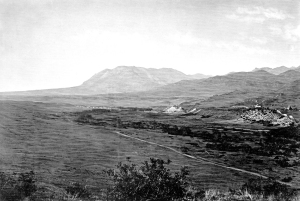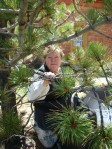Post written and copyright Doris McCraw 2014
In tales of the Old West there was almost always conflict between the sheep and cattlemen. That was a true fact, especially when land became the all important marker for success. As more and more decided to take up cattle ranching, the more land needed to support large herds. In some areas it takes between 40-100 acres per animal. Sheep take a smaller ratio. Recent studies have indicated that grazing the two together may be of more benefit than grazing separately.
In the early to mid 1800’s, both were common in Colorado. In the Pikes Peak Region as the area was growing sheep were a primary source of income for many. Around the young town of Colorado Springs sheep, and the wool they produced was a major industry. In the earliest city directory, 1879, the wool growers outnumber the livestock growers almost 2:1. There were some who were listed as both wool grower and livestock grower.

In the early editions of the local paper, as they were touting the assets of the area, the clean air, the beauty of the scenery, they also spoke highly of the land and its suitability for sheep. If you remember that post on ‘Judge Baldwin’, he had a sheep ranch. The amount of wool shipped was covered and praised in those same papers.
Later cattle became the more popular choice and less and less was heard of the ‘wool growers’. The city directories started combining the two and it became more difficult to track. As the city grew other avenues of income became more important and the livestock industry got less and less coverage. Still, in those early years of the region and a lot of Colorado owe some of its success to sheep and cattle together. Now, Colorado is known for its high mountains, mining and skiing, but those early days are still a fascinating study and those early doctors had more than a bit of contact with and some stories of those days. Until next time, here is to history and the stories they can tell.

HOME FOR HIS HEART by Doris McCraw, available on:
Amazon, Barnes & Noble, Smashwords
Follow my haiku post five days a week at: http://fivesevenfivepage.blogspot.com
“Film & Photography on the Front Range” : the stories of the people who made film and photograph history on the Colorado Front Range. You can buy online at: http://www.amazon.com

I remember learning in high school of the struggles between cattlemen and sheep herders here in Wyoming, but thanks for the Colorado history lesson.
LikeLike
You are welcome Abbie. In later years there were some problems, but when the state was being settled they all did what they could to make a living. Doris
LikeLike
Interesting post, Doris! I like that grazing the sheep and cattle together might be the better option.
LikeLike
Stephanie,
There was a fairly recent study in Australia that came to that conclusion. It was short but interesting. I just think folks should know as much of the whole story as possible about the early days. (Not that I know it all, but research in this area seems to point out the two existed together for a time.) Doris
LikeLike
It seems wool growers and cattlemen still have strong opinions here in Wyoming, and sometimes elsewhere. However, my dad grazed sheep and cattle together on our farm in North Dakota, the sheep ate the gopher brush and other weeds while the cattle ate the grass, and with good management, there was no conflict or competition for the pasture. Interesting post!
Neva
LikeLike
I agree Neva, they just can’t seem to get together. That is what makes the early days so fascinating to me. It sounds like you father understood better than most. Wise man. Thank you for the kind words. Doris
LikeLike
Not from Wyoming or Colorado, so all I really know of cattle ranchers and sheep herders and their feuds are the old TV shows, movies and western novels. I look forward to learning more from you, Doris.
LikeLike
Mike, That was where I learned also. Finding the ‘wool growers’ and sheep information sparked an interest, so off to the research piles to find out why it was different back then. As more is learned, the more that will be shared. Doris
LikeLike
What interesting stuff Doris! I so love the history you bring to light in your writing. Thanks for sharing it with us. I know it’s your passion to dig up stories that might never be told but if for your writing. Good on you!
LikeLike
Thank you Linda. Yes, old newspapers and the resulting research keep me going. It is a good feeling that others enjoy what I share. Makes it worthwhile. Doris
LikeLike
Doris, thanks for the information. I think I could use this in a story. I knew about it, but I hadn’t thought of it for a long time. Nice photos too. Cher’ley
LikeLike
Thanks Cher’ley. If anything sparks the creativity of others, well it makes it all worthwhile. Happy writing. Doris
LikeLike
Great post, Doris! As Neva mentioned, Wyoming has history of bitter battles between sheepmen and cattlemen (Johnson County Wars and others). Amazing to think about feuding over something like that — people have a hard time coexisting with one another a lot it seems!
LikeLike
Gayle, I was surprised at what I found in those early days. Another rabbit hole for me to climb down, (Grin) but oh the fun. I hope to follow through and find out why the conflicts turned out the way they did. Doris
LikeLike
Removing sheep to bring in more cattle is certainly different from Scotland of the 18th and 19th Centuries. Back then PEOPLE were removed from their small crofting farms and replaced with sheep. The herds could freely roam the hills and glens and needed little of the shepherd’s intervention duirng the year to survive. Thank you, Doris. I didn’t know that sheep were a popular commodity in colorado, but I’m guessing they were maybe easier to ship to the US than cattle when the animals first came to the US?
LikeLike
Nancy,
It is a conflicted and interesting story. I do love the story of sheep in Scotland back then. Now you have peaked my interest. Sigh! Doris
LikeLike